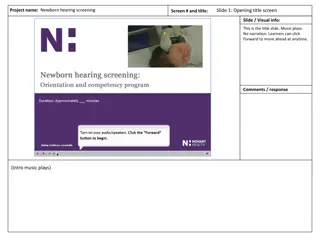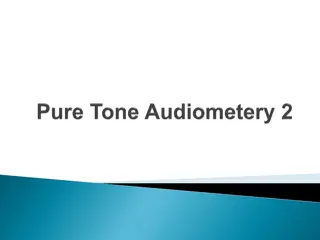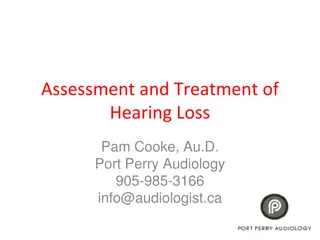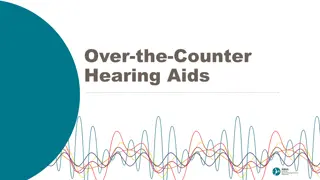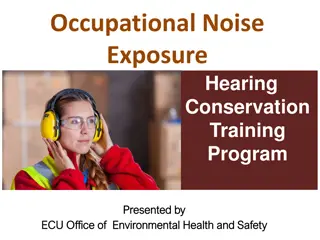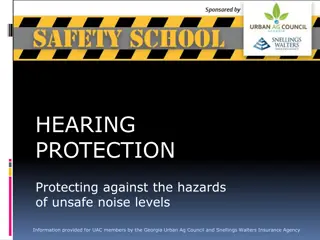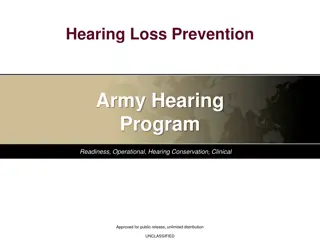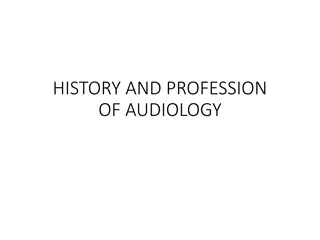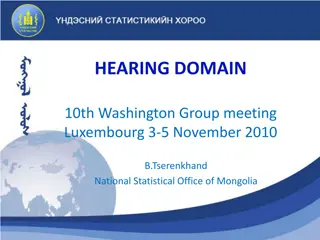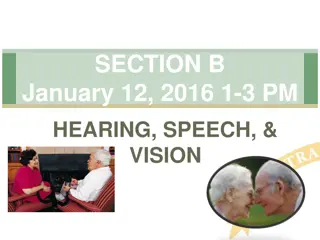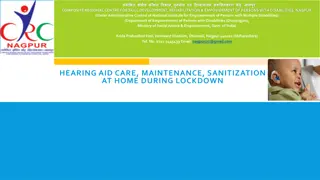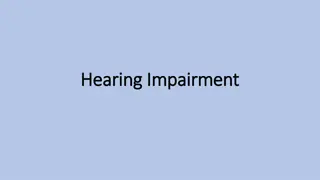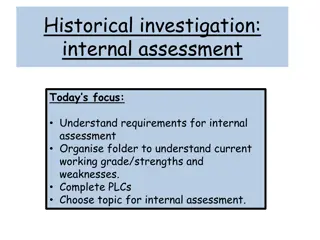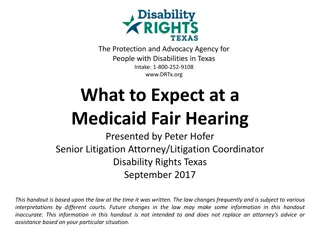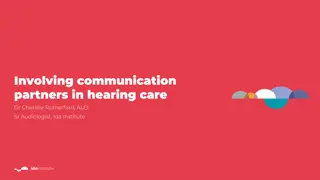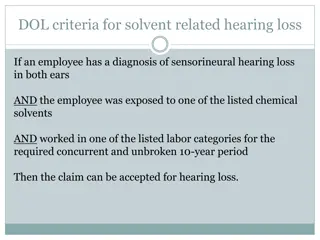Title IX Webinar #3 on Investigation and Hearing Process Changes
This webinar delves into the changes in the investigation and hearing process brought about by the new Title IX regulations. Starting with the formal complaint submission, it covers important aspects such as notice requirements, pre-investigation process documents, and the initiation of the investigation process. Learn about essential elements like when the process formally starts and the key documentation needed to support the process effectively. Get insights into the crucial details to be aware of during the investigative phase, including the provision of notice to all parties involved. Access valuable guidance and resources to navigate these crucial processes effectively.
Download Presentation

Please find below an Image/Link to download the presentation.
The content on the website is provided AS IS for your information and personal use only. It may not be sold, licensed, or shared on other websites without obtaining consent from the author.If you encounter any issues during the download, it is possible that the publisher has removed the file from their server.
You are allowed to download the files provided on this website for personal or commercial use, subject to the condition that they are used lawfully. All files are the property of their respective owners.
The content on the website is provided AS IS for your information and personal use only. It may not be sold, licensed, or shared on other websites without obtaining consent from the author.
E N D
Presentation Transcript
Title IX Webinar #3 Mackenzie Wilfong, Brandee Hancock & Aleigha Mariott July 2020
Lets get started Need more information, a good place to start is the SUNY Joint Guidance https://system.suny.edu/sci/tix2020/ We are providing these presentations to you, use them, modify them. We will close caption these four webinars and place them in the Dropbox. This webinar focuses on the changes to the investigation and hearing process due to the new Title IX regulations, and does not address basic investigation or hearing processes. 2
Concurrent follow up questions
Starting the Investigation Process
When does the process formally start? Day Zero - Submission of formal complaint alleging sexual harassment and requesting investigation to Title IX Coordinator or any other person who would be deemed to have actual knowledge. Formal complaints require a signature so you may choose to set up Maxient or other system intake as a report, follow up with the complainant, and then have a formal complaint which starts the process. 5
Pre-Investigation Process Documents Sexual Violence Supportive Measures Checklist Summary of Resources Investigation Process Overview Checklist Investigation and Hearing Flow Chart Investigation Notice 6
Notice Must provide notice of the allegations of sexual harassment, including sufficient details known at the time and with sufficient time to prepare a response before any initial interview. 106.45(b)(2)(A) For an employee respondent, can interview the respondent without disclosing the complainant s identity, as long as no disciplinary action is taken without following the grievance process (unless emergency removal or administrative leave is permitted). 85 Fed. Reg. 30287 Notice Requirements [ 106.45(b)(2)(B)]: Statement that respondent is presumed not responsible and that a determination of responsibility is made at the conclusion of the grievance process Inform parties they may have an advisor of their choice, who may be an attorney Inform parties they may inspect and review evidence Inform parties of any provision in policy/code of conduct that prohibits knowingly making false statements or knowingly submitting false information during the grievance process Written notice of the date, time, location, participants, and purpose of all hearings, investigative interviews, or other meetings, with sufficient time for the party to participate 7
Reflection on this requirement Before an initial interview with a Respondent, you must provide written notice of allegations to both parties with sufficient time for Respondent to prepare for Respondent s response and to secure an advisor, among other things. You may need to interview a Respondent to determine if a dismissal is appropriate. If so, provide the Notice of Allegations first and then have the first Respondent interview. Likely this interview will be significantly long. You will need to discuss the process, determine if a dismissal is necessary through information you are gathering, and perhaps even discuss informal resolution if that is an option. This is where you would gather information to determine the dismissal basis of it would not constitute sexual harassment even if proved. 8
Supplemental Notice If the investigation uncovers additional allegations which were not included in the initial notice, must provide notice of the additional allegations to the involved parties whose identities are known. 106.45(b)(2)(ii) 9
Where does informal resolution fit? Informal resolution is available [a]t any time prior to reaching a determination regarding responsibility the recipient may facilitate an informal resolution process. I would suggest that if you are going to attempt to utilize informal resolution you mention it early. I was unable to find data about success rates for informal resolution based upon timing in the Title IX process. There are interesting statistics from mediation timing in litigation in the pre- trial phase vs. appeals that may be instructive. This data tells us that those cases most readily amenable to mediation often settle early. 10
Interviews and Evidence changes
Interview scheduling The burden is now clearly on the institution to compile evidence. You must allow sufficient time for the party to prepare to participate before interviews You need to consider this when scheduling the interview. You may want to look at the class schedule, and choose a time when not in class with a reasonable amount of notice and be consistent with this for both parties. This sufficient time standard mentions parties not witnesses presumably they do not require as much time to prepare. 12
Gathering Evidence The burden of gathering evidence sufficient to reach a determination is on the institution, not the parties. 106.45(b)(5)(i). Trauma-informed questioning can be conducted by the investigator. Must provide an equal opportunity for the parties to present witnesses, including fact and expert witnesses, and other inculpatory and exculpatory evidence. 106.45(b)(5)(ii) Parties do not have a right to depose others or issue subpoenas. 85 Fed. Reg. 30306 Cannot restrict the parties ability to discuss the allegations being investigated. 106.45(b)(5)(iii) 13
Right to Review Evidence Both parties must have an equal opportunity to inspect and review any evidence obtained as part of the investigation that is directly related to the allegations, including the evidence upon which the institution does not intend to rely in reaching a determination regarding responsibility and inculpatory or exculpatory evidence, whether obtained from a party or other source. 106.45(b)(3)(vi) Inculpatory evidence that tends to show Respondent is responsible Exculpatory evidence that tends to show Respondent is not responsible No definition of directly related evidence in the Regulations, but may mean more than just evidence that is relevant institution has discretion. 85 Fed. Reg. 30310 Relevance determined by applying logic and common sense but not by applying legal expertise. 85 Fed. Reg. 30320 Investigator should not screen out evidence the investigator does not believe is relevant. 85 Fed. Reg. 30304 14
Two Pre-Hearing Evidence Sharing Opportunities Large production before the investigative report is issued Before the investigator issues their report, the parties must have at least ten days to review any relevant information directly related to the allegations raised in a formal complaint gathered by the investigators, including both inculpatory and exculpatory evidence. More narrow production Create an investigative report that fairly summarizes relevant evidence and, at least 10 days prior to a hearing (if a hearing is required under this section or otherwise provided) or other time of determination regarding responsibility, send to each party and the party s advisor, if any, the investigative report in an electronic format or a hard copy, for their review and written response. 15
Evidence sharing pre-report Before the investigator issues their report, the parties must have at least ten days to review any relevant information directly relatedto the allegations raised in a formal complaint gathered by the investigators, including both inculpatory and exculpatory evidence. At the end of that ten day period, the parties have the right to submit a written response. If the written response triggers additional investigative responsibilities and those responsibilities uncover additional evidence, then the parties will be given another opportunity to respond. This may result in a second cycle of inspection and review of evidence, if not more, so the complexities of this process should be factored into your planning. 16
How do you share evidence? The Department does not require or recommend a particular means of sharing this information. Many institutions have already developed electronic file-sharing protocols in the wake of the Coronavirus/COVID-19 Pandemic to facilitate remote investigations and hearings. What is the DOE trying to address? The Department is critical of policies requiring parties to sit in a certain room in the recipient s facility, for only a certain length of time, with or without the ability to take notes while reviewing the evidence, and perhaps while supervised by a recipient administrator ; such practices have reduced the meaningfulness of the party s opportunity to review evidence and use that review to further the party s interests. 85 Fed. Reg. 30,026, 30,307 17
How do you share it? The parties must have a copy of the evidence in hard copy or digital form, and have to be provided this evidence in a manner compliant with any reasonable request for disability accommodations under applicable law. 85 Fed. Reg. at 30,435. The institution may choose to share records in a manner that will prevent either party from copying, saving, or disseminating the records, but does not have to, which reflects a change from the NPRM. Institutions may specify that parties are not permitted to photograph the evidence or disseminate the evidence to the public. 85 Fed. Reg. at 30,432 Such measures may be used to address sensitive materials such as photographs with nudity. 85 Fed. Reg. at 30,432 Look at the technology chart in the Dropbox to review options. 18
What must be shared pre-report? Share evidence that is directly related to the allegations, even if that evidence will not be relied upon in reaching a determination. The Preamble distinguishes between information that is directly related to the allegations--which must be shared with the parties at this stage in the investigation pre-report--and information that is relevant. 85 Fed. Reg. at 30,304. Only relevant information need be summarized in the investigation report; relevant evidence is defined as more narrow in scope than evidence that is directly related to the allegations. 19
Evidence in an academic record If the academic record of a party is directly related to the allegations of sexual harassment, then the recipient may obtain, access, use, and disclose such evidence as part of the investigation. 85 Fed. Reg. at 30,432 Examples the DOE provides include attendance records. 20
Evidence that is directly related but not relevant Although the complainant s prior sexual behavior is irrelevant under the Final Rule, the institution nevertheless must share prior sexual history if such evidence is directly related to the allegations because it may be offered to prove that someone other than the respondent committed the conduct alleged by the complainant or to prove consent. Id. 21
Privilege and evidence sharing Institutions are advised to maintain a privilege log should they decide not to share certain evidence among the parties. 22
Investigative Report Writing
Investigation Report Investigator/s Names Consent Chart Purpose of Report Review of Supporting Materials Summary of Investigation Process Alleged Violations Involved Parties Information about Interactions (credibility assessment) Incident Specifics Date of Incident Date of Report Location Background Information Reported Information 24
Reported Information Option 1 Reported from Complainant Reported from Respondent Prior to Date Party Jane Snapchatted John and said Hey there is a date party, do you want to come? (pg. 2.10) John arrived at Jane s apartment around 10 pm. Jane offered John a beer and gave it to him while she continued to get ready. Jane asked John to come to her date party after their student organization meeting. John arrived at Jane s apartment around 9pm. Jane gave John a beer, he was never asked if he wanted a beer. On the Bus to the Date Party Jane expressed the bus was full so Jane lapped John on the bus ride to the date party. John was signing her songs that were playing on the bus. Jane defined John was doing this in a sexual nature. Witness, Jill Jill confirmed that Jane and John were on the same bus as her and she say them lapping. Jill did not report seeing anything that would make her think either of them were uncomfortable. John provided video of Jane lapping on the bus. (attachment 2.12) John shared that he sat with his legs close together because he was not comfortable with the lapping situation. After Date Party 25
Reported Information Option 2 Complainant's Reported Information Summary of concerns presented by the complainant are put in paragraph form. Supporting materials are referenced within. Respondent's Reported Information Summary of concerns presented by the respondent are put in paragraph form. Supporting materials are referenced within. Witness Reported Information Summary of concerns presented by each witness are put in paragraph form. Supporting materials are referenced within. 26
Consent Chart Complainant s Account Touching of her breasts by John. Touching of her vagina by John. Jane reports no sexual contact was consensual. Respondent s Account Making out. Touching of Jane s vagina. The making out was mutual. John reports he thought he had consent from Jane so the contact was consensual. Jane came into his room and took her top off. He is not sure how the making out started. John reports the making out was mutual and Jane participated in the kissing. Jane took off her shirt an action of consent. John defines he was drunk. He consumed 10-15 shots of vodka, whiskey, and Baileys he also had a couple of beers. Consumed alcohol to the point where parts of the night he does not remember. What sexual contact occurred? What sexual contact was not consensual? Who is the initiator of the sexual contact? Jane reports John was the initiator of the sexual contact. How was consent given or not given? Jane reports she never gave consent. Level of incapacitation Jane reported consuming not a full solo cup of vodka with a mix, jello shots, and a little bit of dark liquor one to two shots. Jane defines she went to sleep and that her body was in and out of consciousness. Jane defined John was very intoxicated. John knew that Jane has a least one Knowledge of level of incapacitation shot to drink and maybe took shots with other people. 27
Live Hearing Required Institutions must provide for a live hearing to determine responsibility. 106.45(b)(6)(i) No hearing board required; decision-maker can be a single individual. 85 Fed. Reg. 30248 Students are allowed to participate in the decision-making role if institution chooses to do so. Institutional decision as to who is/are decision-maker(s). Consider who will serve as appeal decision-maker as well. Live hearing includes virtual hearings, as long as the parties can see and hear each other. 106.45(b)(6)(i) Institution must create an audio or audiovisual recording, or transcript, of any live hearing and make it available to the parties for inspection and review. 106.45(b)(6)(i) 29
Rules of Procedure Institution is allowed to adopt rules governing the procedural aspects of hearing. 85 Fed. Reg. 30361 Considerations: Can parties make opening or closing statements? Process for making objections to the relevance of questions and evidence? Institution is allowed to have a rule that does, or does not, give parties or advisors the right to discuss relevancy with the decision-maker during the hearing. 85 Fed. Reg. 30343 Reasonable time limitations on a hearing? Defining the roles of individuals in the hearing (i.e. having someone who organizes, having legal counsel present?) Rules of decorum of participants and advisors 30
Questioning During Hearing Each party s advisor must be permitted to ask the other party and any witnesses all relevant questions and follow-up questions, including those challenging credibility. 106.45(b)(6)(i) Parties are not allowed to cross-examine each other or witnesses. Must be done by an advisor or not at all. Cross-examination must be done orally and in real time by the advisor. 106.45(b)(6)(i) Only relevant cross-examination and other questions may be asked of a party or witness. 106.45(b)(6)(i) Before a party or witness answers a cross-examination or other question, the decision-maker(s) must first determine whether the question is relevant and explain any decision to exclude a question as not relevant. 106.45(b)(6)(i) Cannot require written submission of questions before the hearing. 85 Fed. Reg. 30335 31
Relevancy Determination Evidence that is not relevant = information protected by a legally recognized privilege; evidence about a complaint s prior sexual history, any party s medical, psychological, and similar records unless the party has given voluntary, written consent, and any party or witness statements that have not been subjected to cross-examination at a live hearing. Rape Shield - Questions/evidence about complainant s prior sexual predisposition or prior sexual behavior are not relevant, unless they are offered to provide that someone other than the respondent committed the alleged conduct, or if the questions/evidence concern specific incidents of the complainant s prior sexual behavior with respect to the respondent and are offered to prove consent. 106.45(b)(6)(i) If a party or witness does not submit to cross-examination at the live hearing, the decision- maker(s) must not rely on any statement of that party or witness in reaching a determination regarding responsibility; proved, however, that the decision-maker(s) cannot draw an inference about the determination regarding responsibility based solely on a party s or witness s absence from the live hearing or refusal to answer cross-examination or other questions. 106.45(b)(6)(i) Option: consider having party/witness appear at hearing, verbally confirm that investigative report fairly summarizes their statement, and allow parties advisors to cross-examine. Decision-makers must be trained on relevancy. 85 Fed. Reg. 30247 32
Decision Maker The decision maker cannot be the Title IX Coordinator or the investigator(s). 106.45(b)(7). The decision maker is under an obligation to objectively evaluate all relevant evidence both inculpatory and exculpatory, and must therefore independently reach a determination regarding responsibility without giving deference to the investigative report. 85 Fed. Reg. 30314. The decision maker has the right and responsibility to ask questions and elicit information from parties and witnesses on the decision-maker s own initiative to aid the decision-maker in obtaining relevant evidence and the parties have equal rights to present evidence in front of the decision-maker so the decision-maker has the benefit of perceiving each party s unique perspectives about the evidence. 85 Fed. Reg. 30331 Institution could have a hearing officer to oversee or conduct the hearing that is separate from the decision maker. 85 Fed. Reg. 30372 33
Determination of Responsibility Content of Determination of Responsibility: Must be in writing. 106.45(b)(7)(i) Identify the allegations potentially constituting sexual harassment. 106.45(b)(7)(ii) Describe the procedural steps taken from the receipt of the formal complaint through the determination, including any notifications to the parties, interviews with parties and witnesses, site visits, methods used to gather other evidence, and hearings held. 106.45(b)(7)(ii) Findings of fact supporting the determination. 106.45(b)(7)(ii) Conclusions regarding the application of the institution s code of conduct to the facts. 106.45(b)(7)(ii) A statement of, and rationale for, the result as to each allegation, including a determination regarding responsibility, any disciplinary sanctions the institution imposes on the respondent, and whether remedies designed to restore or preserve equal access to the institution s education program or activity will be provided by the institution to the complainant. 106.45(b)(7)(ii) The procedures and permissible bases for the complainant and respondent to appeal. 106.45(b)(7)(ii) The parties must be notified simultaneously. 106.45(b)(7)(iii) 34
Hearing Process Hearing Prep Checklist Guide for Advisors Guide for Individuals Involved in the Process https://studentconduct.okstate.edu/ConductProcess Hearing Notice Hearing Outline Hearing Script 35
Hearing Set Up 3 Options One Room Two or more rooms Video Conference In-Person Considerations Expect participants to be uncomfortable Arrival location Breaks & Departure 36
Video Conference Considerations Password protected Video must be enabled and virtual backgrounds are prohibited Quantity of advisors does not change when it is on video conference Once on video conference Names are changed to be First Last, Role (John Doe, Respondent) Everyone is asked to show their room to check for privacy Mute participants Disable chat, share screen, and rename themselves Lock the Meeting once everyone has joined. Use Break Out Rooms 37
Sanctions and Remedies
Sanctions Regulations do not set out sanctions that should be imposed when a respondent is found responsible. 85 Fed. Reg. 30394 DOE specifically declined to mandate suspension or expulsion recipients deserve flexibility to design sanctions that best reflect the needs and values of the recipient s educational mission and community. 85 Fed. Reg. 30407 Nothing in these final regulations precludes a recipient from adopting a zero tolerance policy. 85 Fed. Reg. 30383 [t]he final regulations do not preclude a recipient from imposing student discipline as a part of an educational purpose that may differ from the purpose for which a recipient imposes employee discipline. 85 Fed. Reg. 30377 Transcript notations The Department intentionally did not take a position on transcript notations or the range of possible sanctions for a respondent who is found responsible for sexual harassment. 85 Fed. Reg. 30394 39
Remedies Treat complainants and respondents equitably by providing remedies to a complainant where a determination of responsibility for sexual harassment has been made. 106.45(b)(1)(i) Remedies must be designed to restore or preserve equal access to the recipient s education program or activity. Remedies may include the same individualized services described as supportive measures ; however, remedies need not be non-disciplinary or non-punitive and need not avoid burdening the respondent. 106.45(b)(1)(i) The Title IX Coordinator is responsible for implementing remedies. 106.45(b)(7)(iv) When the final determination has indicated that remedies will be provided, the complainant can then communicate separately with the Title IX Coordinator to discuss what remedies are appropriate. 85 Fed. Reg. 30392 Remedies that do not directly affect the respondent must not be disclosed to the respondent. 85 Fed. Reg. 30425 40



